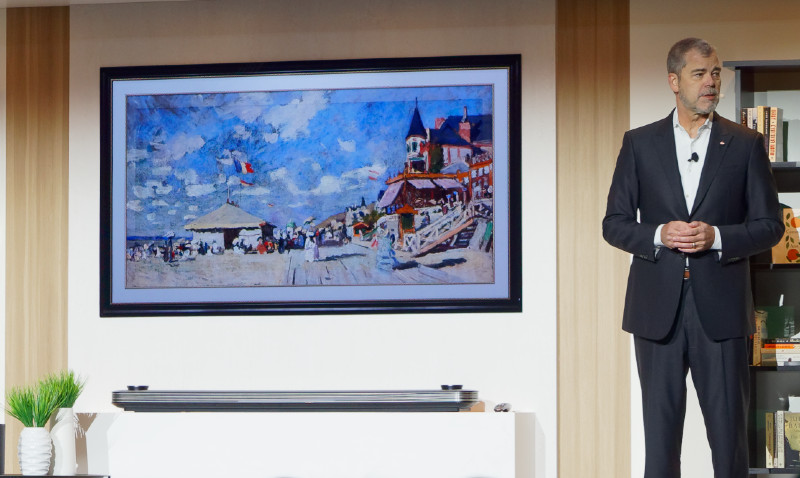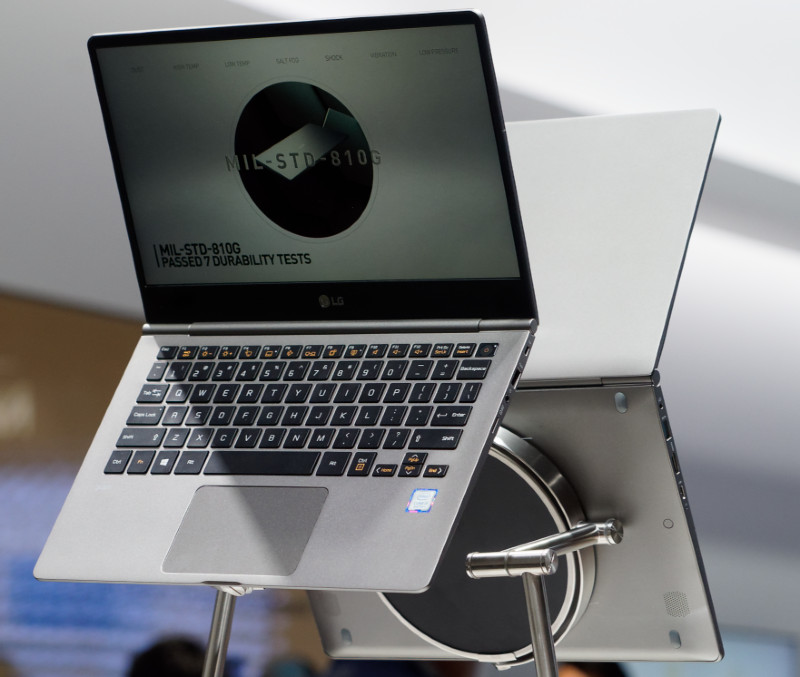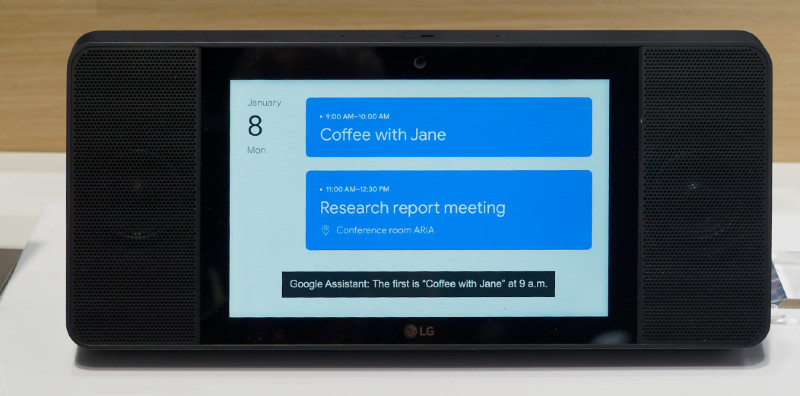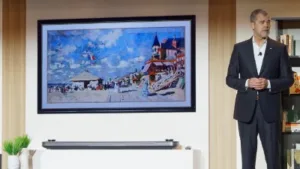LG Press Event
LG held its press event as the first on the day before the main show started and used very wide LED display as the backdrop that looked very good and exploited the wide format, although the audio was a bit heavy for 8.00am!
IP Park, President and CTO of LG Electronics, introduced its ThinQ brand which it will use to stand for its AI functions. The AI technology will extend through the product ranges into household appliances. For example, the LG air conditioning learns the pattern of family living and adjusts accordingly. Another example is that the firm’s robot vacuum cleaner can detect people or pets and avoid them. LG’s car system will watch automatically for driver attention and will learn who is in the car and will optimise settings automatically. The technology uses the integrated wifi and internet connectivity.
 IP Park, CTO LGE, introduced ThinQ. Image:Meko
IP Park, CTO LGE, introduced ThinQ. Image:Meko
LG makes products from home to car to office and the plan from the company is to offer a seamless experience across all these areas.
LG has an automatic washer and steamer. If you have bee out shopping, it can adjust your home conditions ready for arrival.
As well as supporting LG’s consumer products, B2B products will also include more features. There will be new robots and software with the aim of being seamless to external solutions, developed with system partners. The world is too big for single company solutions so LG will adopt open standards and platforms.
Deep ThinQ uses ‘deep learning’ and could improve the image quality of TVs. It can connect to partner services and LG is working with Google and Amazon and open to working with others. Google Assistant is being include in TVs, smart assistants and headphones.
LG expects to find synergies using data from other industries, for example if you combine a personal schedule with information about an electric car, charging can be done at the cheapest time. On the LG booth, LG was showing its ThinQ world.
Scott Huffman of Google came on stage and said that consumers are looking for conversational experiences. LG and Google have collaborated on phones for 1.5 years and now many products including home appliances are connected. LG’s ThinQ speaker is based on Google’s Assistant and so is the ‘Tone’, a wireless headset which has an ‘assistant button’ to activate the microphone and allow connection to the service.
Other features in the speaker include the ability to broadcast messages around the home. It also has an option for multi-step macros so that you can set up for instructions such as “I’m leaving” to automatically make appropriate changes in heating etc.
All LG’s home appliances in 2017 became Wi-fi enabled and now all appliances will be given ThinQ functions.
Got to Have a Robot
LG then introduced its CLOi robot, which is intended to be more interactive than other assistants. It uses the ThinQ technology, but at the event the unit refused to respond, several times. LG’s Styler is a steam system for clothes and LG said that NFC tags on clothes can be used to check the conditions needed for garments (although it wasn’t clear to what extent this kind of technology is being adopted and standardised).
Demonstrations of ThinQ included a fridge advising when food was heading for its sell by date and an oven that then pre-heats itself to match the recipe chosen to use the food up. The latest refrigerator includes a 29″ FullHD Touch display. Other applications shown included devices pro-actively contacting LG’s service department if an early problem was detected, allowing pre-emptive service and also intelligent power saving and management.
There was also a demonstration of an AI TV that we noted as ‘very cheesy’ and the company said that the ThinQ brand would be used in its smart TVs. Features in the TVs that are enabled by AI include:
- easier control
- connection control
- changing picture modes
- content information
- turning off the TV after the end of a programme (for example in bedroom TVs)
- Google Assistant is integrated
- Photo viewing
- Calling Uber
ThinQ TVs will also operate as an IoT hub for smart home control.
 Tim Alessi emphasised that LG is focussed on OLED TV again in 2018. Image:Meko
Tim Alessi emphasised that LG is focussed on OLED TV again in 2018. Image:Meko
Tim Alessi is a Senior Director in Product Marketing and he spoke about developments in LG’s OLED TVs which are now being used for consumer content grading by Technicolor. LG’s new Alpha 9 processor has up to 50% more power and processing (the CPU and GPU are both 35% faster, Alessi said). The increased power is used for ‘four step’ noise reduction which can take into account depth and sharpness. The process identifies objects at different depths in the image and then uses depth-based enhancement rather than edge-based. It separately processes textures and edges. The new algorithm has more accurate colour and there is an expanded CLUT.
The company is developing high frame rates (HFR) and is ready to support 120Hz without judder or blur. Alessi said that LG’s 4K cinema HDR gives c’inematic’ quality. HDR support includes Technicolor, HLG, HDR and Dolby Vision. Dynamic metadata is supported and LG has HLG Pro and HDR10 Pro which are proprietary versions for dynamic tone mapping. All the OLED TVs have support fo Dolby Atmos audio.
Other features include a new ‘Gallery mode’ that is designed to show artwork rather than video and LG has arranged for additional “seasonal destination images” from Trip Adviser to be supplied to sets. The OLED TV range will have five line ups from the wallpaper range down and sizes will be 55″, 65″ and 77″.
 LG’s TVs this year will have a Gallery Mode. Image:Meko
LG’s TVs this year will have a Gallery Mode. Image:Meko
NanoCell was a new technology that was introduced to improve colour performance last year. For LCD, improved viewing angles are a feature of nanocell technology. Full Array LED backlights will be critical this year for viewing HDR.
After the OLED tunnel last year, LG has an’ OLED canyon’ on its booth.
Moving onto robotics, LG already has been testing at Incheon airport in Korea. There are five cleaner robots and guide robots in the airport that are helping LG to develop the AU for robot applications.
On stage were a number of ‘concept robots’ including a ‘Serving Robot’ which could be used for hotel room service or in airport lounges. Another hospitality application is the ‘Porter robot’ which can take luggage to the hotel room. The robot can also support check in and check out.
A shopping cart robot allows users to scan products as they go into the basket and can be used to allow payment when leaving the store.
 LG had three concept Robots for room service, luggage and shopping. Image:Meko
LG had three concept Robots for room service, luggage and shopping. Image:Meko
LG Booth Visit
We have reported the TV and projection products in a separate article. (LG Electronics TVs at CES 2018)
Most years, LGE has shown LFDs at CES, but this year, they were not in view as a lot of the space on the booth was taken up by household appliances. There was an area dedicated to monitors that was highlighting the HDR performance. We reported details earlier, as LG released details before the event. (New LG Monitors Support HDR600). At the event, there was a demonstration of the use of the Thunderbolt 3 interface being used to ‘daisy-chain’ dual UltraHD monitors from a notebook on the 32UK950. The monitor uses the Nano-IPS colour technology to get to 98% of DCI-P3.
The 34″ 34WK95U is a 21:9 monitor that supports 5120 x 2160 resolution and supports HDR6– and 98% of P3, based on NanoIP. The monitor is hardware calibration ready and aimed at content creators. The LG model is the first to support this format on the desktop, although there have been a number of prototypes and concept displays shown in large TV sizes with this level of resolution and 21:9 format.
A second 34″ monitor is the 34GK950G which is a 3840 x 1440 monitor with 100Hz refresh (120Hz overclock) that uses GSync and has LG’s Dynamic Action Sync (which is LG’s version of low latency).
The 27UK650 is a new 27″ UltraHD monitor that has 99% of sRGB and is colour calibrated. It supports HDR10, but was not marked as having special levels of brightness. Inputs are DisplayPort and dual HDMI. The monitor supports FreeSync and has a pivot function. The design is ‘three sided borderless’ and it will cost $550 when it gets released (although there was no date or detailed specification when we went to press).

Before the show, LG released some information on the latest versions of the LG Gram thin and light notebook (Vol 24 #47 Product Round Up)
 There are three models of LG Gram Notebook with different displays. Image:Meko
There are three models of LG Gram Notebook with different displays. Image:Meko
LG had a new Smart Speaker that has a display and is built around Google Assistant. The unit has an 8″ ‘HD’ touch-enabled display. We couldn’t get clarification of the precise resolution at the show, but we were able to find out that the device is built on Qualcomm’s SD624 Home Hub Platform. The assistant won an award as the “best in show”.

Analyst Comment
The 34″ 5120 x 2160 format from LG looks like an interesting format for the desktop. (BR)

